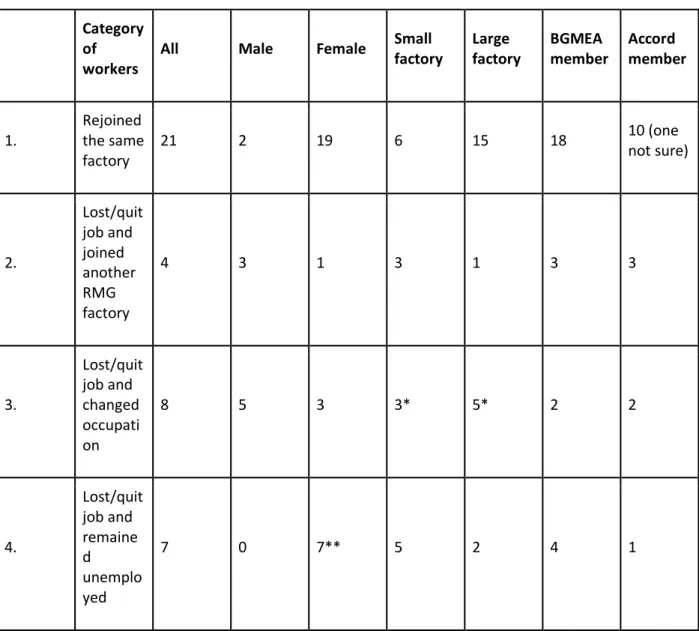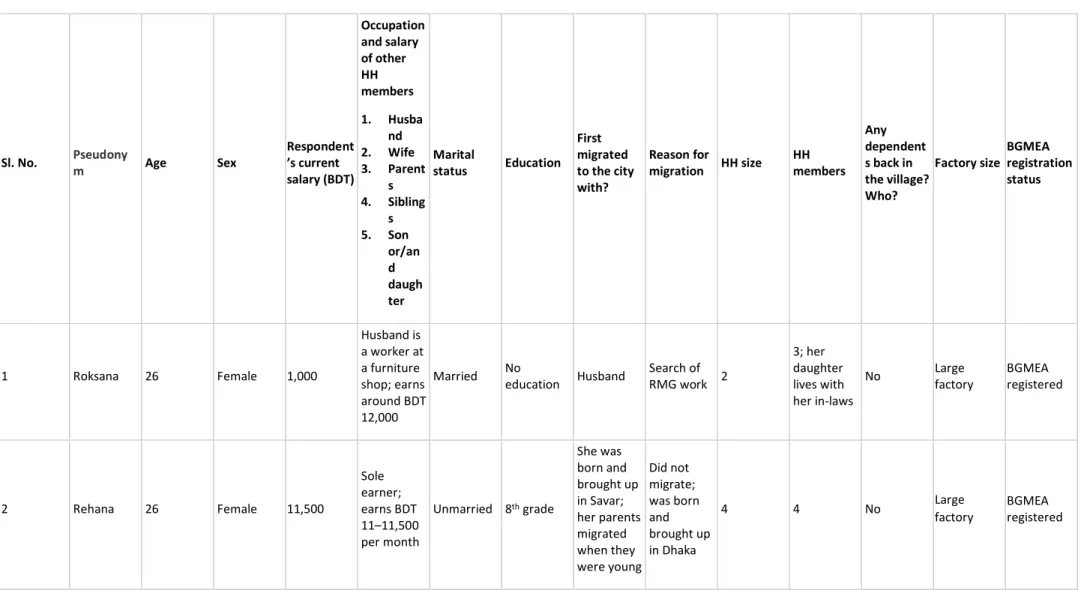One of the challenges that has been associated with COVID-19 is the balance between life and livelihood. The Financial Times once wrote about it as a macro-level problem in an article headlined "The Covid-19 conundrum: lives versus livelihoods", where it talked about the difficult choices policymakers face about whether to prioritize public safety or open their economies. , the health of their citizens or the health of their economies (Dodd, 2020). This brought international pressure on the key players in the apparel value chain.
However, the outbreak of the pandemic in the countries to which Bangladesh supplied its garment exports meant that. Media reports revealed discrepancies in the number of RMG employees who had been retrenched or laid off. The union leaders regularly appeared on television talk shows on the issue of the country's economy, workers' conditions and demands.
However, few studies explored gender issues in the RMG sector during the pandemic in great detail. 4 Project title: "The welfare consequences of employers' responses to COVID-19 on export production in low-income countries".
Conceptual Framework: Livelihoods, Capital, and Capabilities
We identified and categorized the workers according to their gender and type of wage earner (sole, primary or secondary), factory size, registration with BGMEA and affiliation with Accord and Alliance under three broad categories of workers who were re-entered the RMG factory after the shutdown lifted, those , who had changed professions and those who had migrated back to the village. Four of the female RMG workers explicitly stated that they had no education; five stated that they had a primary education, three had a secondary education and one had passed their Higher Secondary Certificate (HSC) examination. Four men lived alone, while eight of the 30 female respondents only lived with their husbands.
The "resources" element of the framework refers to the various resources available to people. It is worth noting that in our survey of female garment workers in 2018, the majority of women believed that garment work was associated with more rights than other forms of employment such as domestic work or agricultural work (Kabeer et al., 2018). One of the reasons they enjoy these rights has to do with the nature of the garment industry in Bangladesh and its location in global value chains that are based in Western countries with active civil societies pressuring garment traders to adhere to certain minimum labor standards in factories that source them. their clothing from.
Although garment factory jobs are classified as formal, the actual formality of the job varied. And because the women in our study were more likely than men to be located in small, unregistered factories, some of the gender differences in their experiences of the pandemic reflected these differences in location.
Findings From the Study
- Life Before COVID-19
- Learning About the Pandemic (8–25 March)
- Coping With Lockdown (March–May 2021)
- Managing Expenditures
- Return Migration
- External Support
- The Post-Lockdown Period
- Factory Responses
- Workers’ Trajectories Post-Lockdown
- Lives Versus Livelihoods: Workers’ Perspectives
Most of the workers in our study learned about the virus from TV, but registered factories began to raise awareness of the pandemic long before the lockout was announced and received. Two of the women from the small factories in our study were directly involved in these protests. After the arrival of the virus, they called us to a meeting and the owner explained the situation.
The factory has been closed for the past three months since it was shut down in March due to the lockout. We went on leave, but we received that month's salary on the 10th of the following month when the factory reopened". Their utility bills were also higher as they had to stay at home most of the day.
We had some savings that we drew on, but we had to go hungry some of the time. Two of the workers said they had considered sending their children to work, not because of financial difficulties, but to learn some skills. It was customary in certain factories to give workers a cash bonus on the occasion of the Bengali New Year.
Some of the smaller factories working on a subcontracting basis had faced considerable difficulties during the lockout. Some of them opened at the end of the lockout period, but had to close again because they failed to receive orders. But it is worth noting that all respondents in our study said that they had not been infected during the lockdown and believed that neither had any employees in their factories.
Have you ever heard that any poor person died from the virus; most of the victims were among the wealthy. The workers of large factories and of the smaller, registered factories faced a shorter period of collapse than others and recovered from it more quickly. Eleven of the 30 female workers and eight of the 10 male workers lost their jobs either because they were fired or because the factory closed due to the drop in orders.
A number of registered workers referred to the negative impact of the lockdown on the livelihoods of others rather than on themselves. Robiul, top winner, small unregistered factory (Chinese company) Those from smaller or unregistered factories were more likely to prefer an early reopening while maintaining precautions, even if they were aware of the risks to their lives.
Concluding Observations
So how can we know what the bosses are up to?” She noted that the virus has brought more restrictions to people's lives, but added, “for us poor people, it's not a change”. They understood that the factory owners could not pay full wages or that they did not receive any help from their owners; they knew nothing about the support they received from the government. Dilara believed that workers were willing to work and that factories could remain open if proper safety measures were taken.
But there has been a turnaround in the industry's performance as buyers have started reviving most of the canceled orders. The value of the country's total exports was USD 3.91 billion in July, the highest monthly estimate in the country's history. There were several recommendations by organizations in the country on how best to protect the industry and the workers during the pandemic.
On the issue of coordinated action, IndustriALL7 called for the creation of a tripartite monitoring task force (government, employers and the IndustriALL Bangladesh Council) under the leadership of the Ministry of Labor to ensure compliance with labor regulations. Based on research conducted in 2017 on the views of various stakeholders in the garment industry in Bangladesh, including workers, regarding the impacts associated with Agreement and Alliance agreements (Kabeer et al., 2020), we had supported the idea of a "shared responsibility model" presented by Barrett et al. 2018) to address persistent deficits in labor standards in the industry. The second theme relates to calls for cash support for workers' day-to-day expenses and the government's decision to provide the industry with an incentive package that would allow it to provide this support.
Our research shows that the more privileged sections of the garment workforce, those working in registered factories, benefited from these facilities. Our previous research into domestic workers revealed what this meant for some of the world's most vulnerable workers. The instrumental need to support garment workers because of their role in generating the country's foreign exchange should not deter the government from paying more attention to the needs of the people. other workers of the country.
Taijul, one of the garment workers in this study, suggested that the government should support the basic needs of the entire population, workers and citizens. In other words, he advocated a broad-based safety net approach that reflected the government's obligations rather than the country's foreign exchange needs. A proactive approach to providing such a safety net would prevent the most vulnerable workers from suffering and protect them from future crises.
Vulnerability, Resilience and Recovery in Readymade Garment (RMG) Enterprises in Bangladesh: An Impact Assessment and. One-quarter of BGMEA plants flout government order, police say: Unions say 30,000 jobs disappear in one month. The impact of Covid-19 on the lives of garment workers: a rapid survey jointly conducted by BRAC University's CED and JPGSPH and the Subir and Malini Chowdhury Center for Bangladesh Studies at the University of California, Berkeley.
March RMG wages still unpaid in 370 factories: Workers continue demo for full wages for April. One female and one male RMG worker lost jobs from large factories (both foreign factories), and three male RMG workers resigned from large factories. Two female RMG workers quit their jobs for their own reasons and five female RMG workers lost their jobs.

Appendix
Man is. a garment Married No data No data No data 6 Male, 2 . sons, Parents Little BGMEA . male);.
